Real World DirectX 10 Performance: It Ain't Pretty
by Derek Wilson on July 5, 2007 9:00 AM EST- Posted in
- GPUs
Lost Planet: Extreme Condition
Lost Planet: Extreme Condition is a port of an Xbox 360 game. Well, to be honest, it's almost as if they just tacked on support for a keyboard and mouse and recompiled it for Windows on x86 hardware. While we haven't done a full review of the game, only playing through the intro and first mission, our initial assessment is that this is absolutely the worst console port ever.
Unless you have an Xbox 360 controller for your PC, the game is almost unplayable. The menus are clunky and difficult to navigate. Moving in and out of different sections of the main menu requires combinations of left and right clicking, which is patently absurd. If during gameplay you wish to change resolutions, you must click the mouse no less than a dozen times. This does not include the need to navigate menus through hovering (who does that?) and the click required to grab the scroll bar in the settings menu.
The console shooter has always had to work hard to compete with the PC. Halo and Halo 2 did quite a good job of stepping up to the plate, and Gears of War really hit one out of the park. But simply porting a mediocre console shooter to the PC does not a great game make.
That said, if you can get past the clunky controls and stunted interface, the visuals in this game are quite stunning. It can also actually be fun and satisfying to shoot up a bunch of Akrid. Our first impression is that a good game could be buried underneath all of the problems inherent in the PC port of Lost Planet, but we'll have to take a closer look to draw a final conclusion on this one.
For now, the important information to take away is what we get from the DirectX 10 version of the game. While we haven't found an explicit list of the differences, our understanding is that the features are generally the same. Under DirectX 10, gamers can choose a "high" shadow quality option while DX9 is limited to "medium". Other than this, it seems lighting is slightly different (though not really better) under DX10. From what we've seen reported, Capcom's goal with DX10 on Lost Planet is to increase performance over their DX9 version.
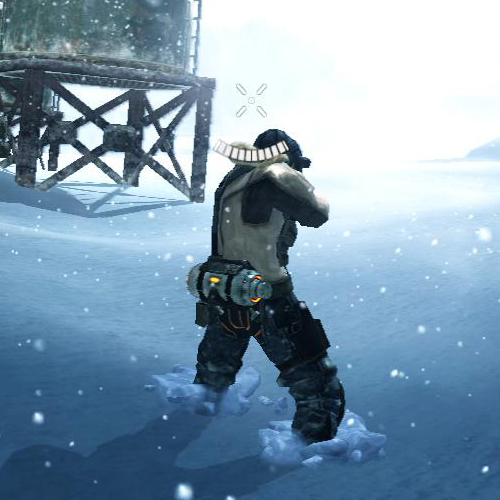
Lost Planet DirectX 9

Lost Planet DirectX 10
In order to make as straightforward a comparison as possible, we used the same settings under DX9 and DX10 (meaning everything on high except for shadow quality).
DirectX 9 Tests

Lost Planet DX9 Performance


Lost Planet 4xAA DX9 Performance
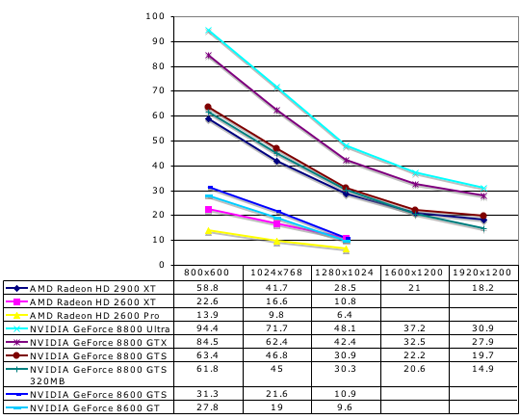
While it's difficult not to feel like a broken record, we need to disable quite a few settings to get our low-end cards playable. In this case, even under DX9 without AA enabled they don't perform well. We are planning on testing the 8500 and 8400 in the near future and we'll be sure and go back to see if we can run DX10 tests at low enough settings to get interesting results for these budget and mainstream parts.
Also, once again, the 2900 XT performs well under DX9, but slips a little behind with 4xAA due to it's lack of MSAA resolve hardware.
DirectX 10 Tests
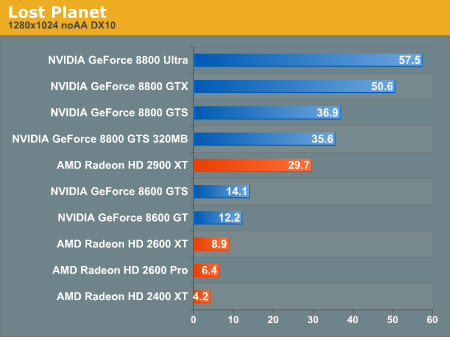
Lost Planet DX10 Performance
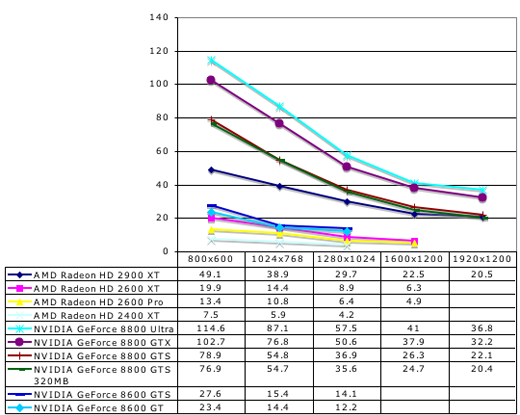
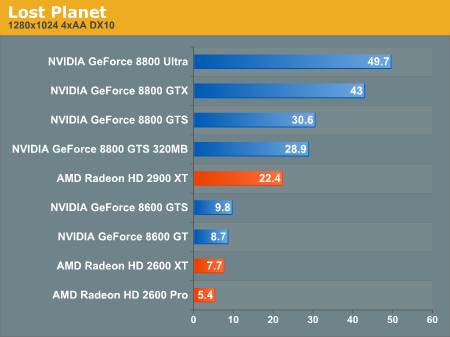
Lost Planet 4xAA DX10 Performance
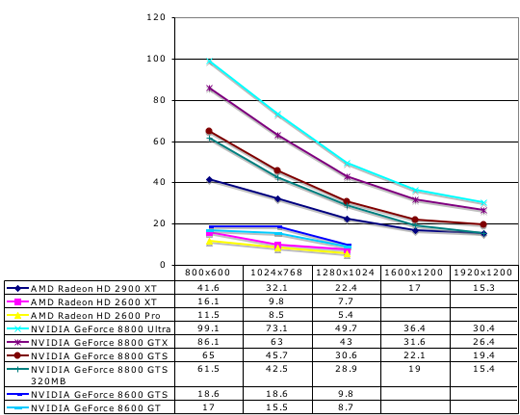
Incredibly, NVIDIA's 162 drivers combined with the retail version of Lost Planet actually deliver roughly equivalent performance on DX9 and DX10. While Capcom's goal is higher performance under DX10, we would still expect that AMD and NVIDIA both have a long way to go in bringing their DX10 drivers up to parity with the quality of their DX9 drivers.
Lost Planet: Extreme Condition is a port of an Xbox 360 game. Well, to be honest, it's almost as if they just tacked on support for a keyboard and mouse and recompiled it for Windows on x86 hardware. While we haven't done a full review of the game, only playing through the intro and first mission, our initial assessment is that this is absolutely the worst console port ever.
Unless you have an Xbox 360 controller for your PC, the game is almost unplayable. The menus are clunky and difficult to navigate. Moving in and out of different sections of the main menu requires combinations of left and right clicking, which is patently absurd. If during gameplay you wish to change resolutions, you must click the mouse no less than a dozen times. This does not include the need to navigate menus through hovering (who does that?) and the click required to grab the scroll bar in the settings menu.
The console shooter has always had to work hard to compete with the PC. Halo and Halo 2 did quite a good job of stepping up to the plate, and Gears of War really hit one out of the park. But simply porting a mediocre console shooter to the PC does not a great game make.
That said, if you can get past the clunky controls and stunted interface, the visuals in this game are quite stunning. It can also actually be fun and satisfying to shoot up a bunch of Akrid. Our first impression is that a good game could be buried underneath all of the problems inherent in the PC port of Lost Planet, but we'll have to take a closer look to draw a final conclusion on this one.
For now, the important information to take away is what we get from the DirectX 10 version of the game. While we haven't found an explicit list of the differences, our understanding is that the features are generally the same. Under DirectX 10, gamers can choose a "high" shadow quality option while DX9 is limited to "medium". Other than this, it seems lighting is slightly different (though not really better) under DX10. From what we've seen reported, Capcom's goal with DX10 on Lost Planet is to increase performance over their DX9 version.

Lost Planet DirectX 9

Lost Planet DirectX 10
In order to make as straightforward a comparison as possible, we used the same settings under DX9 and DX10 (meaning everything on high except for shadow quality).
DirectX 9 Tests




While it's difficult not to feel like a broken record, we need to disable quite a few settings to get our low-end cards playable. In this case, even under DX9 without AA enabled they don't perform well. We are planning on testing the 8500 and 8400 in the near future and we'll be sure and go back to see if we can run DX10 tests at low enough settings to get interesting results for these budget and mainstream parts.
Also, once again, the 2900 XT performs well under DX9, but slips a little behind with 4xAA due to it's lack of MSAA resolve hardware.
DirectX 10 Tests




Incredibly, NVIDIA's 162 drivers combined with the retail version of Lost Planet actually deliver roughly equivalent performance on DX9 and DX10. While Capcom's goal is higher performance under DX10, we would still expect that AMD and NVIDIA both have a long way to go in bringing their DX10 drivers up to parity with the quality of their DX9 drivers.










59 Comments
View All Comments
jay401 - Friday, July 6, 2007 - link
They're right though, the charts need work. They are not intuitive and there are multiple better ways to present 'percent change' data that would make sense on first glance without the reader having to decipher an unintuitive method that is contrary to the readability of the article.DerekWilson - Friday, July 6, 2007 - link
The dx9 vs dx10 scaling graphs have been altered to present the data in a different way.Please let me know if this is still not adequate.
Andyvan - Thursday, July 5, 2007 - link
I had the exact same reaction to the charts. For the Lost Planet chart with the two colors, either pick better (more standard) colors, or make the performance drop bars grow to the left (or down), and the performance increase bars grow to the right (or up).-- Andyvan
PrinceGaz - Thursday, July 5, 2007 - link
The best thing to do with those charts is change them to show relative performance in DX10 compared to DX9, with 100% meaning no change (same performance in DX10 as DX9). Improvements with DX10 give scores above 100%, reduced performance gives a result below 100%.Doing that would make the graphs much easier to understand than the current mess.
sterlinglittle - Thursday, July 5, 2007 - link
This might be a silly question as I can't recall the current status of MultiGPU performance with Vista drivers. Will it be possible to test these games with SLI/CrossFire configurations soon?gigahertz20 - Thursday, July 5, 2007 - link
The results show exactly why I am waiting to buy a DX10 video card, all these people who rushed out to buy a Geforce 8800GTX or AMD 2900XT..hah..especially all those 2900XT fanboys who said the R600 would destroy the 8800GTX in DX10 benchmarks because it has 320 stream processors and a 512-bit memory interface....well guess what, the benchmarks are in and they show the R600 is still the power hunry POS video card it is.KeithTalent - Thursday, July 5, 2007 - link
I'm not sure how it is a 'hah' to the people that purchased these cards as they still blow everything else out of the water in DX9, I mean it is not even close.So for those of us running at higher resolutions (1920x1200 or higher), an 8800/2900 or two made perfect sense (and still does). I doubt very many people were expecting great DX10 performance right away anyway, particularly as the games available barely make use of it.
KT
Sceptor - Thursday, July 5, 2007 - link
I agree with your idea, I've always skipped over one generation of hardware to another.Especially when users are still "testing" Vista gaming for Microsoft, Nvidia and AMD I see no need to part with my money until performance is at least on par with DX9.
Good article...Nice to see some real numbers on DX10 vs DX9
DerekWilson - Thursday, July 5, 2007 - link
there are applications where the 2900 xt does outperform its competition, as is shown by call of juarez.it really depends on how developers go forward. we'll have to wait and see what happens. judging the future of AMD/NVIDIA competition under dx10 isn't really feasible with only 3 apps to go by.
one thing's for sure though, we'd love to see better performance out of the mainstream parts from both camps. And having some parts to fill in the gap between the lower and higher end hardware would be nice too.
defter - Thursday, July 5, 2007 - link
I think the point here is that many claimed that "R6xx is designed for DX10, don't judge it based on DX9 performance blah blah blah". Those claims gave the impression, that relative DX10 performance of R6xx series will be much better than their DX9 performance.Your tests show that on average, R6xx takes a HIGHER performance hit from moving to DX10. Thus, under DX10 R6xx is even SLOWER than it was under DX9.